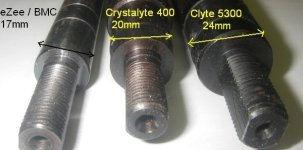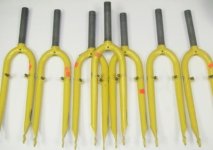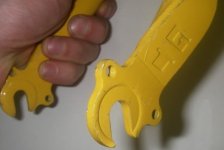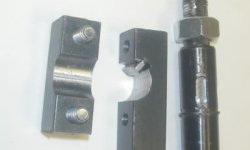Affliction said:
The axle's are harder than stainless? I cut threads in these all the time and it's like cutting butter with my tap and die kit.
You can't drill stainless unless you have special drill bits and usually the bit is ruined once you're done.
You sure your torque arms are true stainless steel?
The reason you have a difficult time cutting stainless is its tendency to work-harden. A drill bit trying to push through stainless steel produces a lot of pressure, and like when you bang a welding rod flat with a hammer at room temperature, the surface of the stainless becomes harder and more resistant to cutting. Only stainless has a much much higher tendency to react this way to machining than mild steel or even the higher carbon alloys. You shouldn't be ruining drill bits if you use a proper cutting fluid, feed rate, and speed with a decent drill press. Even with a regular bench top you should be able to get a few holes drilled before the bit goes dull and you have to sharpen it again.
You might try using your tap and die on a SS bolt the same size as the axle sometime...there
may (and I say may because I haven't done this myself) be a noticeable difference in the machine-ability. Something like a 1080 steel might be soft if it isn't heat treated...but try machining it after a good temper is put into it. The higher carbon stuff has higher tensile and yield strengths, but that doesn't necessarily vary directly with its machining characteristics.
justin_le said:
For sure, we'll get to know for sure early next week. ... It might be that the hardened torque plates just cut through the axles at only a little more torque than the axles were cutting through the softer plates, but we'll see.
Cool, I'm glad that thought already crossed your mind and it sounds like we'll be informed of the characteristics sooner than I thought! You may also want to keep an eye on the profile of the cut edges. A perfect corner (that is, un-rounded) can have a higher tendency to form stress fractures.
Slightly rounded corners may help that quite a bit. You probably don't want the torque arms to be
too hard...in fact I hypothesize that the R/C hardness should about match that of the axle. Ideally there will be no friction wear on the torque arm/axle at all if the nuts are tight and the axle doesn't move much relative to the dropouts...but sometimes people forget as you've pointed out. :wink:
live4physics said:
The most commonly used alloy of stainless steel is 304.
It has a tensile strength of of 73,000ksi and a yeild strength of 31,000ksi
Are your units kg/in^2? I can't remember off the top of my head what ksi is...
GaryKard said:
What I would want to know is if dual torque arms offer twice the resistance to spinout or do they give more or less protection than that. Not two arms with one reversed for regen but two mounted the same direction.
Two torque arms would double the ability of the torque arms to hold a moment, and probably the total ability to hold a moment by 20-30% (thats a S.W.A.G.), but the real limit relates to the ductility, shear strength, and hardness of the axle and torque arm material. It's a lot like how a crescent wrench doesn't get dented when you strip a nut or bolt head with it...the material of the bolt head didn't have enough hardness so it mushed over instead of tightening further. Does mounting a torque arm backward make a different for regen? I'd be interested to know if it does because I want to play with this on my next build (a few years out of course).





